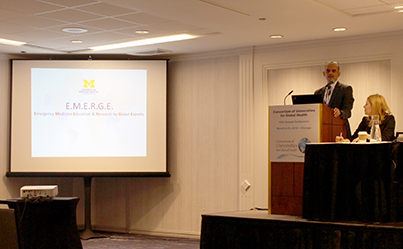The vision of Professor of Emergency Medicine and Pediatrics, Prashant Mahajan, the Emergency Medicine Education and Research by Global Experts (EMERGE) network launched less than a year ago and already includes 10 sites across 8 countries. This May, leaders from each of the network’s partner institution emergency departments will gather in-person for the first time during a three-day conference in Ann Arbor, kicking off their collaborations in earnest.

“I have been very enthused by the interest we’ve received in our network. We’ve quickly grown quickly beyond the conceptual stage and we now have an established framework for partnership across several areas, from Emergency Medicine research to education and training,” said Mahajan, MD, MPH, MBA. “We’ve seen a great deal of interest and enthusiasm from all over the world.”
In addition to Michigan Medicine and Wayne State University, the network to date includes emergency medicine departments at select hospitals in Austria, Brazil, China, Finland, Ghana, India and Taiwan. Many, like Peking University Health Science Center, in Beijing; Komfo Anokye Teaching Hospital, in Kumasi; and All India Institute of Medical Sciences, in New Delhi, are longtime institutional partners of Michigan Medicine through Global REACH.
The hope is to create a global platform to conduct multi-national studies on emergency conditions, study the epidemiology of emergencies in a global context, understand emergency care delivery systems, learn from and implement best practices to improve access and reduce variation in emergency care delivery and improve the overall quality of care. Emergency medicine is a relatively young specialty, having been officially recognized in the US since 1979. While a few international emergency medicine networks exist, none include member institutions from both developed and developing countries. That is one of the strengths of EMERGE, Mahajan said, because all departments, regardless of geography, bring a lot of unique expertise and insights to the table.
“There are issues that are common across the sites, such toxicology, sepsis, or resuscitation,” he said. “At the same time, some sites develop individual expertise because they encounter specific kinds of trauma or illness more frequently than others. Our network can help facilitate sharing those best-practices. There are many possibilities for potential collaboration.”
Mahajan gave an oral presentation about his efforts to develop the network during the annual Consortium of Universities in Global Health (CUGH) meeting in Chicago in March, and EMERGE was recently featured in a CUGH-focused special issue of The Lancet Global Health as well.
The first-ever EMERGE conference will take place May 11-13, 2019 and is expected to draw around 60 attendees, collectively, from the respective partner sites.

“We’re looking forward to hosting everyone in Ann Arbor this spring,” said Emergency Department Chair Robert Neumar, MD, PhD. “I continue to be very enthused about the possibilities with this network. There’s the potential to have a big impact in Emergency Care across the world.”
Leading up to the conference, the partner institutions have been holding bi-monthly conference calls to organize the EMERGE network, establishing everything from overall mission, goals and research priorities, to protocols for proposal submission and review, data sharing, and so on. Michigan Medicine is hosting a computer data coordination center to help the institutions collaborate once the research collaborations begin in earnest. Coordinating multi-institutional collaborations across many time zones and languages is complex endeavor. The health records across the partner sites use no fewer than five languages (English, Chinese, Portuguese, Finnish, and German), and the taxonomies used to document cases in the emergency department varies from institution to institution.
“There are complicating factors because of the large scope of project, but we believe the benefits of a truly global network make the effort worthwhile,” Mahajan said. “So much depends on building relationships and understanding the similarities and dissimilarities between each system, and each of the member institutions is committed to our success.”
